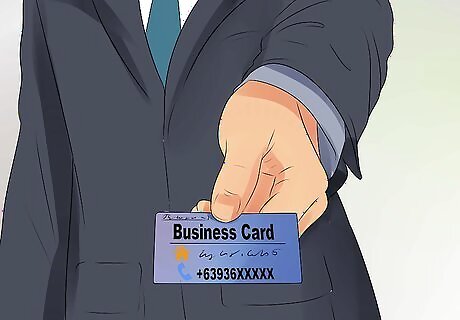
views
Developing Your Marketing Strategy

Decide on the ultimate goal of your marketing efforts. The main goal of marketing is to attract customers and keep them. However, the specific marketing goal for your business can vary, depending on your existing product’s position in the marketplace. In some cases, your product may only be a concept. Some examples of other marketing goals include: Increasing sales. If you have an existing product or service, your marketing goal may be to simply increase sales. For example, if you currently sell to 5% of the market, you may want your marketing to help you sell to 15% of the available market. Moving into new markets. If you have already done well with one specific market, then your marketing goal may be to generate sales in a new market. For example, if you sell products to the outdoor hiking and biking market, you may decide to move into other sports markets (football, baseball, basketball). Regaining sales. At some point, you may start to lose business to a new competitor. If customers are considering a competitor’s product, then your marketing efforts should be to convince them to stay with your brand.

Build your brand equity (or awareness). Once you decide on your ultimate marketing goal, you can work on your brand equity. Even if your goal is to increase sales or enter a new market, you’ll need to review your brand equity. Your brand equity is how customers perceive your product as better than your competitors and what makes your product different. One way that marketers build brand equity is by telling stories. Your story needs to explain the problem and why the problem is important to the customer. The problem needs to be important enough to be solved right away. Your story should offer a solution and explain how that solution solves the problem. For example, in a vacuum commercial, the person in the commercial has a vacuum that can’t clean up a large amount of dirt on a carpet. The carpet gets more and more dirty. The commercial presents a more powerful vacuum as a solution. The buyer is happy with the results.

Research the market for your product. Market research can help you to identify your best customers and that will help you design a marketing strategy that targets those customers. Conducting market research can also help you to identify potential threats, reduce risks, and spot opportunities to increase your sales. One simple way to research your market is to look back over your past sales to figure out who is buying your products. For example, do college students make up the majority of your market? Tourists? Teachers? Try to identify the type of person who buys your products most often. In addition, you should analyze competitor marketing approaches and their results, even though the latter may have to be estimated. Try to understand what they are doing right and what they could do better. Your findings can then be implemented in your own marketing approaches. You can also look at government statistics on your consumers as well to learn more about their purchasing habits. Look for these statistics at https://www.sba.gov/content/consumer-statistics.

Use mail surveys to learn more about your market. Mail surveys can help you learn important information about your target customers. You can put whatever information you want to know on customer surveys. For example, you can ask people how often they buy your product and the price they are willing to pay for your product. When creating your survey, make sure that you: Keep questions short and direct. Include questions that will be interesting and relevant to the respondent. Keep the survey under two pages. Make it look professional with a nice cover letter. Send a reminder if you have not received the survey within a week. Include a self-addressed, stamped envelope to make it easy for respondents to return the survey.

Conduct phone interviews. Phone interviews can help you to get information from people living in different regions, which is why they can be a valuable part of your market research. When contacting customers by phone, there are some things that you should keep in mind. Make sure that you confirm the name of the customer or business when you call. Avoid any silence during the phone call. Follow-up as needed. Only mention the survey when you have someone on the line, not as a message.

Sort your customers into groups. If you have enough data, you can break your customers into groups and examine buying patterns in these groups. For example, you may find that one group of customers buys your product often, while another group only occasionally buys your product. Looking at this information should help you to determine who is buying your product and how best to reach them. You can separate your customers by a variety of factors, like age, income, geographical location, education level, and so on. Once you know which specific group or groups buys your product the most, you can then target your marketing strategies more directly at them. For example, if you find that a large portion of your customer base is made up of college students, think about the best ways to reach them. You may want to post fliers around campus, run an ad in the student newspaper, or send out emails to students. You can also sort your customers by geographical location. For example, if your business tends to do business in certain regions of the country, then you can plan to target that market with region specific advertising.
Marketing Online

Create an attractive website. The first place many customers will learn about your business is by viewing your website, so it is important to invest the time and resources to make your website engaging for the viewer. Even if you cannot sell your product or service online, having a website is an essential part of a good marketing strategy. You can use an online publishing platform to create an attractive website. For example, WordPress offers hundreds of website templates you can use. You don’t need to know how to write code to set up your site. Most customers make a decision about whether or not to spend time on your website based on your home page. Ensure that the look and text on your home page gets people’s attention. Keep in mind that you can always hire someone to build your website for you if you do not think you are up to the task.

Make sure that your website is easy to navigate. It is important to make it easy for your customer to navigate your website. If a viewer wants to see more of your site, make sure that they can navigate to other web pages easily. The customer should be able to find links and drop down menus quickly. If the website is hard to browse, people will not stay on your site. Keep in mind that all of the content on your site needs to connect to solving a particular customer problem. Your client has an urgent problem, and you have a solution. As you build your website, keep that concept in your mind.

Improve your product website’s search engine optimization. Search engine optimization (SEO) can help to increase the traffic to your website. SEO is the process of increasing your site’s search ranking when someone searches a keyword or phrase. There are a number of ways to increase your product website’s ranking including: Hire a subject matter expert to create content for your website. For example, if you product is meant to help people lose weight, then you should have a personal trainer, physician, or dietician create blog posts or videos for your website. Get more businesses to link to your page. Find relevant websites and contact them about sharing your product. You may be able to arrange for them to link to your product website by entering into an agreement to also promote their products. These businesses should be complementary and noncompetitive to your own. Make sure that your website is mobile-friendly. Many people browse the internet on their smart phones, so it is important to make sure that your website supports mobile use. Talk to your website manager about making your website mobile friendly. Ensure that the language on your site is clear and easy to understand. People view sites and read the text on your page very quickly. If your text is simple and clear, you’ll get your message to the client before they lose interest.

Post useful content on your site to attract more customers. Google has changed their search ranking criteria to put a bigger emphasis on content. If your site includes content that your viewers find useful, you can move up in the Google search rankings. Perform a Google search for keywords and phrases that relate to your product. See what types of blog posts and articles are ranked highly in your search. Consider writing blogs and articles on those topics. As you add content to your site, give readers the opportunity to opt-in and receive more content from you. Many websites have a pop-up ad or a button for viewers to opt-in. The reader provides their email address and receives more content from you, usually by email or using an email newsletter. Your best business leads are the people who opt-in and request more content. Make sure that you provide great content to this valuable audience.

Consider the costs and benefits of using online ads. You can place ads on the Internet. These ads appear to the viewer, based on the keywords and phrases they enter into a search. This can be an effective approach, because your ad matches the exact language a customer cares about in their search. These ads increase the chances that a customer will click on your ad to learn more about your product. Google AdWords can help you determine the specific cost for an ad, and the number of people who will see the ad and click on it. You can estimate the number of ad viewers who eventually buy your product. That estimate will help you determine if the cost of the ad will generate sufficient revenue. Be aware that an increasing number of people are using various forms of ad blockers. These are software applications designed to block ads. If you set up a campaign and notice that you’re not getting good results, it may be due to ad blockers. Work with a tech expert to use ads that avoid these blockers. Marketers must be more creative about the type of ads they use. Traditional banner ads placed at the top or along the side of a website do not generate the interest they used to. Consider other ads formats that generate more interest.
Using Traditional Marketing Tools

Try print coupons and mailers. Many people still respond to these traditional methods of advertising and they cost about the same as pay per click advertising. Make sure that your coupons and mailers provide customers with a special offer and create a sense of urgency as well. Many consumers search out coupons and make sure to use them for purchases. This group is strongly motivated to buy if they can save money. You can provide coupons by email or regular mail. Many businesses also offer coupons to customers when they make a purchase. The coupon can be printed on the sales receipt. Customers also pay attention to mailers, particularly a mailer for local businesses they use. You can include a coupon or some other offer in a community business mailer.

Use print ads and TV advertising. You can also advertise in local newspapers and print media. Contact the advertising department for your local newspaper or TV station. If you’re not familiar with this process, you can hire an advertising firm to place ads for you. Place an ad in your local newspaper and see if it increases your business. To determine if the ad is working, ask new customers how they heard about you. Consult an ad agency with experience in your local TV market for help. They can help you estimate a budget for your TV commercial, and the size of the audience your commercial will reach. Once you have that information, you can decide if TV advertising makes financial sense for you.

Implement a joint promotion strategy. You can consider doing joint promotions with complementary businesses. Think about products and services that people may buy together. Marketers refer to this as bundling. When you buy ice and a cooler, for example, you may also want to buy food for a cookout. For example, if you own a restaurant and you’re close to a movie theater. You can work with the theater to promote both businesses. People who go to the theater can get a coupon to visit the restaurant. The restaurant can offer discounted movie tickets.

Write a newsletter to send out to customers. One good way to tell customers about new products while also maintain a relationship with them is to send out a regular newsletter via email or regular mail. You can send it out once per month or once per quarter. Some things that you may want to say in your newsletters include: product updates staff changes special offers complementary information, such as how to use your product in an innovative way

Carry business cards wherever you go. Talking to people about your business and giving them your business card is still a great way to market your business. Make sure that you always have a stack of business cards with you when you are out. If you end up having casual conversation with someone about what you do, offer the person a business card with your contact information.




















Comments
0 comment